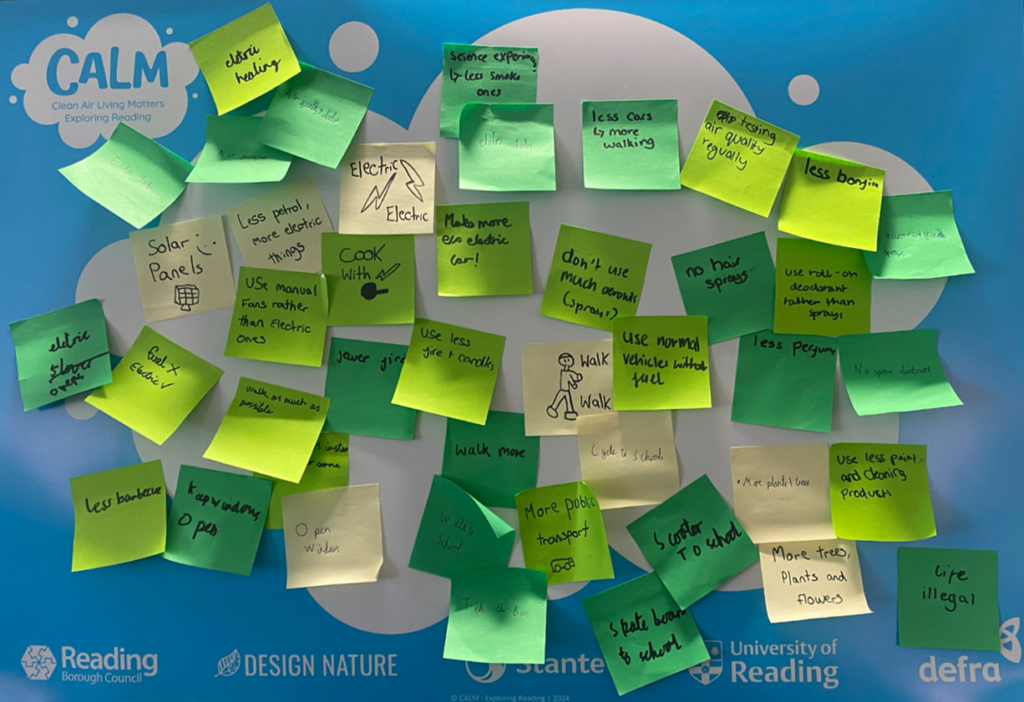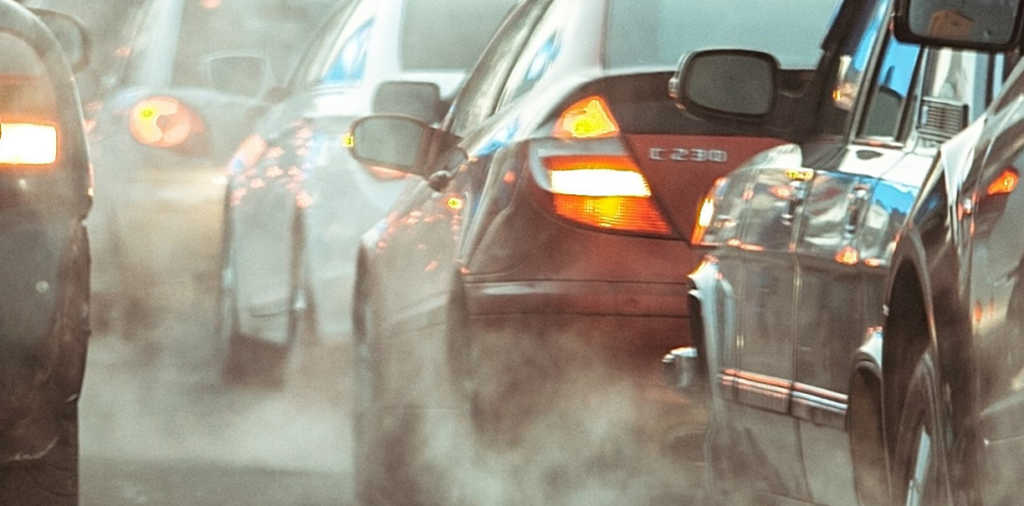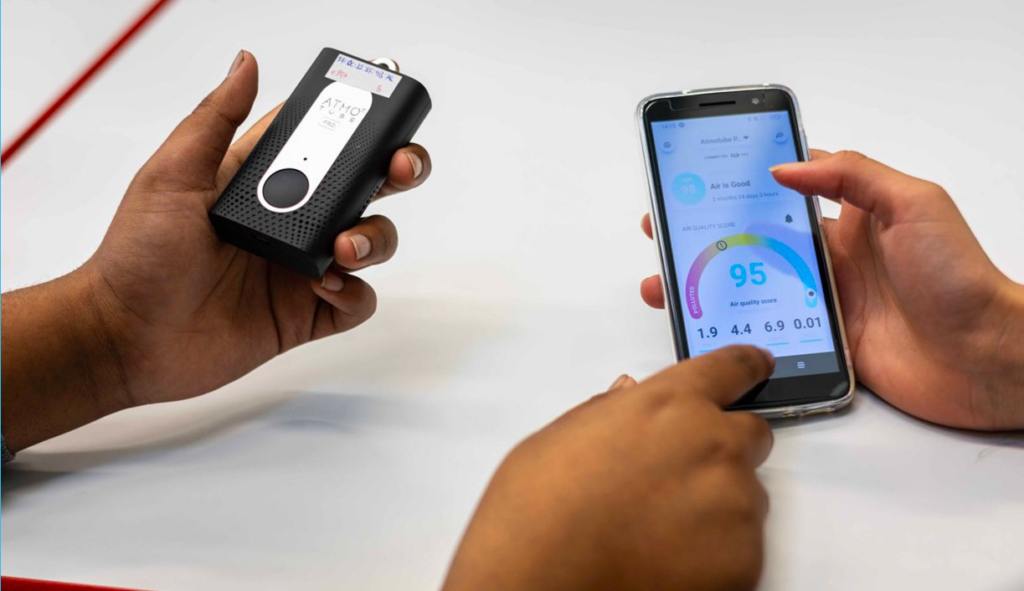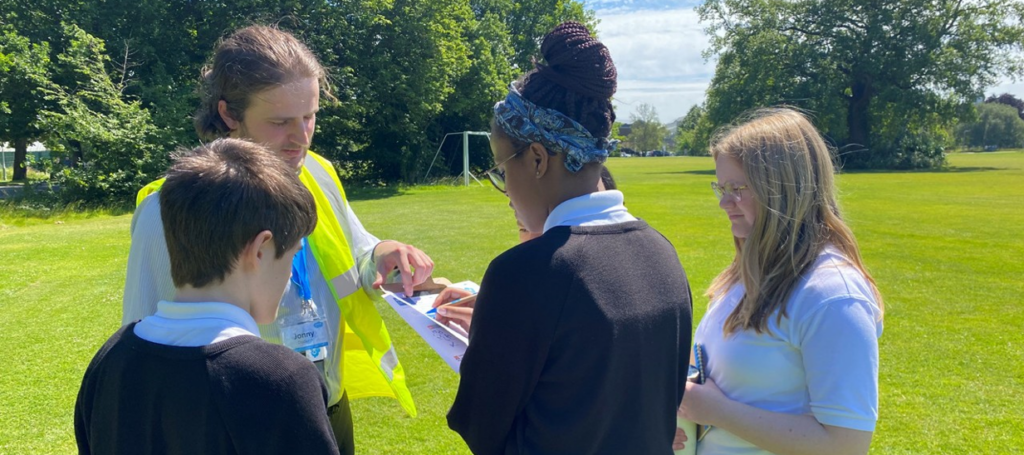Your Guide to Air Quality Education
Clean Air Living Matters: Exploring Reading
On this page you can explore:
- What is air pollution
- Air pollution: impact on health
- Air quality education in schools
- Air quality in Reading and Smoke Control Order
- Actions you can take to improve air around you
- More about CALM:ER project and useful links

Here is an example of an activity undertaken with schools where the pupils can write their ideas on how the air quality can be improved and what can be implemented to change behaviours.
Welcome to the CALM:ER approach to air quality
This page aims to raise awareness of air pollution and give guidance on how to improve the air you breathe, minimise or avoid your exposure to outdoor and indoor air pollution.
The Clean Air Living Matters: Exploring Reading (CALM:ER) project is funded by DEFRA (Department for Environmental, Food and Rural Affairs).
The project has been collaboratively developed and delivered in partnership between Reading Borough Council, University of Reading, Design Nature and Stantec.
Printable (inaccessible) booklet version of the information on this page.
What is air pollution?
Air pollution is a mixture of particles and harmful gases that can have a negative effect on health and well-being. This can be experienced in indoor and outdoor environments.
There are many pollutants that can make the air quality worse. Two pollutants that are of most concern are Particulate Matter (PM1, PM2.5 or PM10) and Nitrogen Dioxide (NO2).
- Particulate Matter are small particles at various sizes which come from wood burning and dust and also engine and tyre wear
- Nitrogen Dioxide is linked to coal, oil, or diesel burned at high temperatures
- Other examples of dangerous pollutants include ground level Ozone (O3), Sulphur Dioxide (SO2), Carbon Dioxide (CO2) and Volatile Organic Compounds (VOCs)

Some schools are located close to busy roads often with high volumes of traffic. Cars and lorries emit harmful pollutants that can have an impact on the air quality around sensitive locations like schools.
Outdoor air pollution
Outdoor air is often referred to as ambient air. The most common sources of outdoor air pollution are emissions caused by combustion processes from motor vehicles, solid fuel (for example, wood, charcoal, coal and peat) burning and industry. Other pollution sources include smoke from fires, windblown dust, and biogenic emissions from vegetation like pollen.
Indoor air pollution
Indoor air pollution includes dust, dirt, or gases present in the air inside buildings. This can be at home, work, or school. Indoor air pollution is a mixture of pollutants inside a building from building materials, furniture and furnishings, cooking, heating, smoking and use of paints, varnishes, cleaning products and air fresheners. Like outdoor air pollution, the pollutants inside your home can impact on your health. Those most at risk are young children and adults with existing lung and heart conditions.
Pollutants generated outside a building can also migrate indoors through windows or other means of ventilation. Heating and cooking appliances and tobacco smoke are the most impactful indoor sources of pollution in UK homes.
Air pollution: impact on health
Air pollution has been linked to a number of health issues which include conditions like heart and lung disease, breathing difficulties, lung growth issues, dementia, miscarriage, mental health and reduced cognitive ability.
Air pollutants mostly irritate the airways and lungs, but long-term exposure to air pollution can also affect the brain and heart and can have a negative impact on pre-existing conditions, or could lead to other diseases like dementia and lung cancers later in life.
Air quality and children’s health
Children belong to a vulnerable group because they’re still growing, their airways are small and they breathe more often.
Exposure to air pollution can lead to:
- Wheezing, coughing and shortness of breath
- Poor lung development and reduced lung function as adults
- Increased risk of infections
- Aggravation of pre-existing conditions (like asthma)
- Impacts on concentration and cognitive functions
The CALM:ER project educates school children and local communities on the importance of clean air and ways to reduce exposure to polluted air.
“Improve or move!”
The ‘improve or move’ approach recommends consciously choosing a way of travelling to avoid polluted air when we are unable to improve it at the time.
Through engagement with children via various activities and assemblies, the CALM:ER team educate families by inviting children to include adults in conversations on air pollution.
Air quality education in schools
Educational sessions, workshops and hands-on activities have been used to engage and educate children from primary and secondary schools in and around the Reading borough. Air quality is directly connected to climate change and it is important for this subject to be communicated widely.

Students use a hand held device, connected to a mobile device, to measure air quality. Results can be viewed on an app or extracted as an excel file to investigate further.
Personal hand held air monitors have been used to undertake monitoring experiments in schools. Students use a map of the area and monitor PM and VOCs at various locations, assessing and investigating the level of air pollution. The educational sessions have links to the National Curriculum, and support STEM, English and Geography subjects.
“… the school has made a real effort to encourage children to walk or cycle to school (…) They have installed ‘No idling’ signs on the school railings to encourage parents (…) to turn off their engines. They have asked parents who do drive to park further away from the school and walk to avoid congestion and exhaust fumes near the school gates ….”
Mother of a primary school child, Reading.

Key Stage 3 students taking part in an outdoor air quality measurements during the Clean Air Day workshop.
Following practical activities, students discuss the best way to take actions:
- How to influence someone in a position of power and communicate their findings (by writing a letter or inviting them to school to respond to their questions).
- How to influence their parents or local community (by designing a poster or a leaflet, sharing their findings in the school newsletter).
- How to take action as a school (for example by developing and implementing a climate action plan, a school travel plan, a walking bus) and inform other pupils and school staff.
Air quality in Reading
Reading Borough Council is continuously working to improve air quality in all areas of the Borough. The success of this work also depends on every person’s commitment to improve the air around us.
1. Air quality action plan
The main aims of Reading’s action plan are:
- To reduce road NOx & PM emissions in Reading
- To reduce air pollution exposure of individuals in locations where vulnerable people are present (children, elderly and those with pre-existing conditions)
- To encourage, enable and support people and businesses to move from high polluting to zero emission transport or energy
- To inform and educate people on the financial, environmental and health benefits of active travel, modal shift and reducing emissions through our daily lives
- To inform, educate and enforce compliance on domestic wood burning regulations, to reduce local PM2.5 emissions
- To improve our monitoring network and planning requirements to support other projects and ensure new developments align with the aims of the Air Quality Action Plan
2. School streets in Reading
A School Street is a road/part of a road directly by a school which is temporarily shut to traffic during the school’s drop-off and pick-up times.
As a result, a safer and healthier environment is created for everyone which helps to tackle air pollution and road danger around schools. This scheme helps to encourage active travel to school for children and families to improve the local environment for everyone.
3. Reading Borough Council Smoke Control Order
A Smoke Control Order is being implemented across the whole of Reading as of 1 December 2024, aiming to reduce the levels of air pollution and to improve the air quality for local residents and the wider environment. It is a legally defined area where you must not emit a substantial amount of smoke from a chimney, or you may face a fine.
Why do we need a Smoke Control Order?
Domestic combustion (including wood burning) is the biggest source of PM2.5 emissions in the UK. PM2.5 particles are roughly 30-times smaller than a human hair and are small enough to travel to the bloodstream and the brain, leading to serious human health impacts.
What can you burn in a Smoke Controlled area?
Residents can only burn authorised or ‘smokeless’ fuels. Wood can only be burned in an exempt appliance and should be labelled Ready to Burn (RTB) to make sure it has a moisture content below 20%.
Exempt appliances, such as multi-fuel and wood-burning stoves, must have been tested and recognised as an exempt product by DEFRA. Exempt appliances can be found in Section 20 and 21 of the Clean Air Act.
Actions young people can take to improve air quality
1. Transport
- Walk, cycle or scoot when you can
- Use public transport or car–share
- Ask your parent not to idle when waiting
2. Spread the word
- Talk to your teachers, friends and family about air quality
- Make everyone aware about the danger of air pollution
- Express and share your opinion (you can write, draw and blog)
Action parents can take
Encourage your children, their friends and family to walk, cycle or car-share and reduce the amount your family uses the car.
- Keep your tyres inflated & service your vehicle regularly.
- Switch the engine off while waiting and only start your engine when you are ready to travel.
- Use the Start/Stop button when at lights or stuck in traffic.
- Avoid rapid acceleration and heavy braking: they both increase fuel consumption and air pollution.
- Reduce use of fireplaces and only use authorised fuels.
- Make sure your home is well ventilated — open windows when possible.
- Use low organic compounds (VOCs) cleaning products where possible.
- Limit the use of candles and incense at home.
- Always use your extractor hood when cooking.
- Reduce condensation in the house by drying clothes outside or in well-ventilated area.
” People could park their cars a bit further away and not literally by the gate… Maybe park a little bit further away and then just take the two minutes’ walk; don’t leave your car running.”
Mother of a primary school child, Reading.
More information on the CALM:ER project
CALM: Exploring Reading with Schools
This information was prepared by Marta O’Brien from the University of Reading with support from the CALM:ER team (Design Nature and Stantec) for Reading Borough Council’s project funded by the Department for Environment, Food and Rural Affairs.
For more information about this project, air quality or the Smoke Control Order, please contact Ross.Jarvis@reading.gov.uk.
Find out more about air quality at: